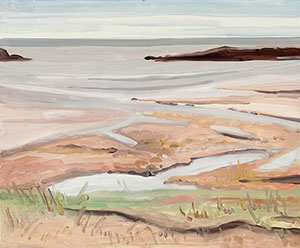George Billis Gallery Elizabeth O'Reilly October 22 - November 16, 2013 back
Stylistic Flair and Rhythmic Conviction
Combining deft brushwork with evocative color, the work in Elizabeth O’Reilly’s ninth show at George Billis rewards in all the ways we’ve come to expect. Her 31 small landscapes, cityscapes and shore scenes make nature seem new and vital; they capture its bright changeability – its shifting effects of sunlight and shadow, and curious alignments – with a bold, stylish attack. Many go further, uncovering in her subjects something especially difficult and rare: deeper identities arising from a painting's unfolding rhythms.
In every work here, brushstrokes summarize objects, large and small, with keen energy. Rapid, broad marks fill in the larger areas of roofs, lawns or tree canopies, emphasizing their planar aspect; smaller, adroit strokes economically pick out details, such as the crevice in a seaside cliff, ripples in water, a sequence of distant tree trunks, each delineated with a single stroke.
The elegant manner of O’Reilly’s attack speaks of confidence and flair, but more impressive is her color, which not only records but characterizes. In “Double Black House and Chimney,” for instance, the band of sky – pale but dense blue – tangibly presses around the deeply shadowed note of a chimney. In “Beach at Brow Head,” a sequence of colors animates the receding planes of a panoramic view: an opaque, grayed beach leading to the incandescent green of surf, then the ocean’s deep, retiring ultramarine blue – all spreading below the sky’s strikingly warm bluish-white. “Tide Coming In” hints at Matisse’s early landscapes in its delight of limpid but rigorously locating color; in this gem, the artist recreates the effect of meandering rivulets of water, dividing and measuring the ruddy pink breadth of a beach, before giving way to a brilliantly yellow-streaked sky.
In the very best of these paintings, the drawing accelerates the movements among colors; forms become as vigorous in rhythm as they are agile in technique. Among these is “White Boat, White House,” in which a cabin glows softly in shadow, a mid-toned blue. By itself, it would hold the entire middle section of the panel with a kind of self-absorbed placidness. But, pressed all around by intense slivers of background color – sky, sun-warmed grass, deeply shadowed boughs – its bulk resists, acquiring weight, scale, location: pictorial character, in short. The cabin’s broad, energized mass, in turn, sets off the sparks of surrounding sunlit detail. It’s a poignant example of how an artist’s compositional inventions, weighted in color, uncover a deeper characterization. It’s the type of expression that Corot achieved with consistent rigor, Constable luminously if irregularly, and Andrew Wyeth hardly at all.
The exhibition includes three watercolors and a collage of watercolor-tinted paper. Both of these media are particularly unforgiving, involving – to enlist the old art-school adage – a “planning of the spontaneous.” Curiously, all four works rank among the most vital in the show. They include “Carroll St. Bridge,” in which a bridge’s pale, slender towers interrupt the massed greens of trees; above, compacted buildings contrast with the hazily reflective, narrowly modulated body of water filling half the sheet of paper below. Pictorially, the image recreates, in a few square inches, the flesh-and-blood expansiveness of the real scene. How to re-create the breadth of life on a slip of paper? As O’Reilly demonstrates, painting has its ways.
George Billis Gallery
521 W. 26th St., New York NY 10001
212-645-2621 · www.georgebillis.com back
